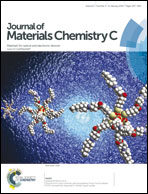Multicolor tuning and white light emission from lanthanide doped YPVO4 nanorods: energy transfer studies†
Abstract
Nanorods of YPxV1−xO4:Ln3+ (Ln3+ = Dy3+, Eu3+, Sm3+) have been synthesized hydrothermally. The substitution of vanadium (V5+) by phosphorous (P5+) ions in YVO4 was confirmed by X-ray diffraction studies and also supported by Fourier transform infrared spectroscopy, transmission electron microscopy and photoluminescence (PL) studies. The energy transfer (ET) rate to the activator can be controlled either by activator concentration or by doping with P in the crystal. The ET is reduced by P doping due to the increase in separation between vanadium ions. This has been established from both steady state luminescence and decay studies. The controlled ET leads to the blue color emission from the vanadate (VO43−) transition in YPxV1−xO4 and generates a multicolored light emission even with single doping of the activator. Further, the color of emission can also be tuned by multiple doping of the activators. Interestingly, white light is obtained by doping with Dy3+ (1 at.%) and Sm3+ (0.75 at.%) in YP0.8V0.2O4. The quantum yield of white light emission is found to be 25%. CIE chromaticity supports the tunability of the light and the white light emission.


 Please wait while we load your content...
Please wait while we load your content...